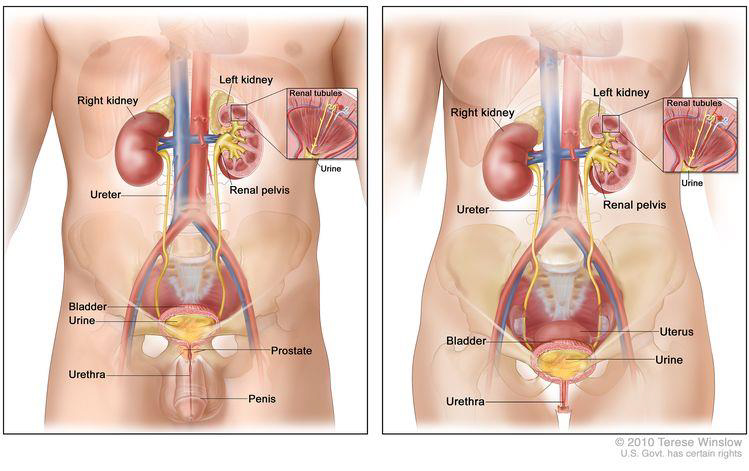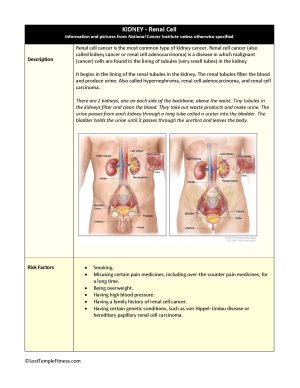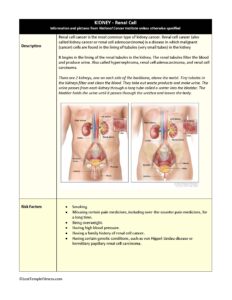Kidney / Renal Cell Cancer
Your Body is Your Temple
Research, Resources & Education
Table of Contents
Kidney cancer is a serious condition that affects the kidneys and can be referred to by different names. It is caused by malignant cancer cells in the kidney which can spread if not treated. Symptoms can include blood in urine, back pain, and weight loss. Treatment options include surgery, radiation therapy, and chemotherapy. Early detection and prompt treatment are crucial for better outcomes.
Information and pictures from National Cancer Institute unless otherwise specified
|
Kidney Description and Cancer

There are 2 kidneys, one on each side of the backbone, above the waist.
- Tiny tubules in the kidneys filter and clean the blood. They take out waste products and make urine.
- The urine passes from each kidney through a long tube called a ureter into the bladder.
- The bladder holds the urine until it passes through the urethra and leaves the body.
- Renal cell cancer is the most common type of kidney cancer.
- Renal cell cancer (also called kidney cancer or renal cell adenocarcinoma) is a disease in which malignant (cancer) cells are found in the lining of tubules (very small tubes) in the kidney.
- It begins in the lining of the renal tubules in the kidney.
- The renal tubules filter the blood and produce urine.
- Also called hypernephroma, renal cell adenocarcinoma, and renal cell carcinoma.
Kidney Cancer Videos
YouTube Videos that help explain types of Kidney / Renal Cancer.
Disclaimer:
This is for research only and Lost Temple Fitness & Cancer does not endorse any video presented on this website.
It is advised that you ALWAYS CHECK WITH YOUR PHYSICIAN for a proper diagnosis and treatment plan.
Kidney Cancer
Treatment for Renal Cell / Kidney Cancer
Also see Treatments
Surgery to remove part or all of the kidney is often used to treat renal cell cancer. The following types of surgery may be used:
- Partial nephrectomy: A surgical procedure to remove the cancer within the kidney and some of the tissue around it.
- A partial nephrectomy may be done to prevent loss of kidney function when the other kidney is damaged or has already been removed.
- Simple nephrectomy: A surgical procedure to remove the kidney only.
- Radical nephrectomy: A surgical procedure to remove the kidney, the adrenal gland, surrounding tissue, and, usually, nearby lymph nodes.
When surgery to remove the cancer is not possible, a treatment called arterial embolization may be used to shrink the tumor.
- A small incision is made and a catheter (thin tube) is inserted into the main blood vessel that flows to the kidney.
- Small pieces of a special gelatin sponge are injected through the catheter into the blood vessel.
- The sponges block the blood flow to the kidney and prevent the cancer cells from getting oxygen and other substances they need to grow.
After the doctor removes all the cancer that can be seen at the time of the surgery, some patients may be given chemotherapy or radiation therapy after surgery to kill any cancer cells that are left. Treatment given after the surgery, to lower the risk that the cancer will come back, is called adjuvant therapy.
The following types of biologic therapy are being used or studied in the treatment of renal cell cancer:
- Nivolumab: Nivolumab is a monoclonal antibody that boosts the body’s immune response against renal cell cancer cells.
- Interferon: Interferon affects the division of cancer cells and can slow tumor growth.
- Interleukin-2 (IL-2): IL-2 boosts the growth and activity of many immune cells, especially lymphocytes (a type of white blood cell). Lymphocytes can attack and kill cancer cells.
- Radiation therapy
- Targeted therapy
- Chemotherapy
Risk Factors and Possible Side Effects
Risks
- Smoking.
- Misusing certain pain medicines, including over-the-counter pain medicines, for a long time.
- Being overweight.
- Having high blood pressure.
- Having a family history of renal cell cancer.
- Having certain genetic conditions, such as von Hippel-Lindau disease or hereditary papillary renal cell carcinoma.
Possible Side Effects
A person can live with part of 1 working kidney, but if both kidneys are removed or not working, the person will need dialysis (a procedure to clean the blood using a machine outside of the body) or a kidney transplant (replacement with a healthy donated kidney).
Kidney transplant may be done when the disease is in the kidney only and a donated kidney can be found.
- If the patient must wait for a donated kidney, other treatment is given as needed.
Dialysis The process of removing blood from an artery (as of a patient affected with kidney failure), purifying it by dialysis, adding vital substances, and returning it to a vein — also called hemodialysis
Surgery
- Infection
- Pain
- Bleeding
- Potential Kidney failure
Biological therapy
- Fluid buildup in the lungs
- Difficulty breathing
- Kidney damage
- Intestinal bleeding
- Rapid heart beat
Recovery from Kidney Surgery
Information from CETI
Please follow MD/surgeon protocol, as every situation is unique.
Hospital Stay
Full Recovery
Restrictions
Exercise
Permanent Contraindications
If participating use extra protective padding.
Other Recommendations
- Avoid exercises that use your abdominal muscles and strenuous activities such as bicycle riding, jogging, weightlifting, or aerobic exercise until your doctor says it is okay.
- For at least 6 weeks, avoid lifting anything that would make you strain.
- Hold a pillow over the cuts the doctor made (incisions) when you cough or take deep breaths. This will support your belly and decrease your pain.
- Do breathing exercises at home as instructed by your doctor. This will help prevent pneumonia.
- Absolutely no heavy lifting or exercising (jogging, swimming, treadmill, biking) for six weeks or until instructed by your doctor.
- Transplant recipients can engage in virtually any type of exercise or sport. Only those sports that regularly involve direct blows to the kidney are discouraged
Disclaimer: The information in this book/website is for educational purposes only and has been obtained through research, publications and personal experience, and shall not be liable for incorrect information. Any mentioned publications or websites does not imply endorsement. As this industry is ever changing, I urge readers to confirm the information contained in this book/website. The author will not be liable for any injuries sustained from practicing techniques taught or for any typographical errors or omissions.
It is advised that you always check with your medical doctor or physical therapist before starting an exercise program or change in diet.
|
Information and pictures from National Cancer Institute unless otherwise specified |




